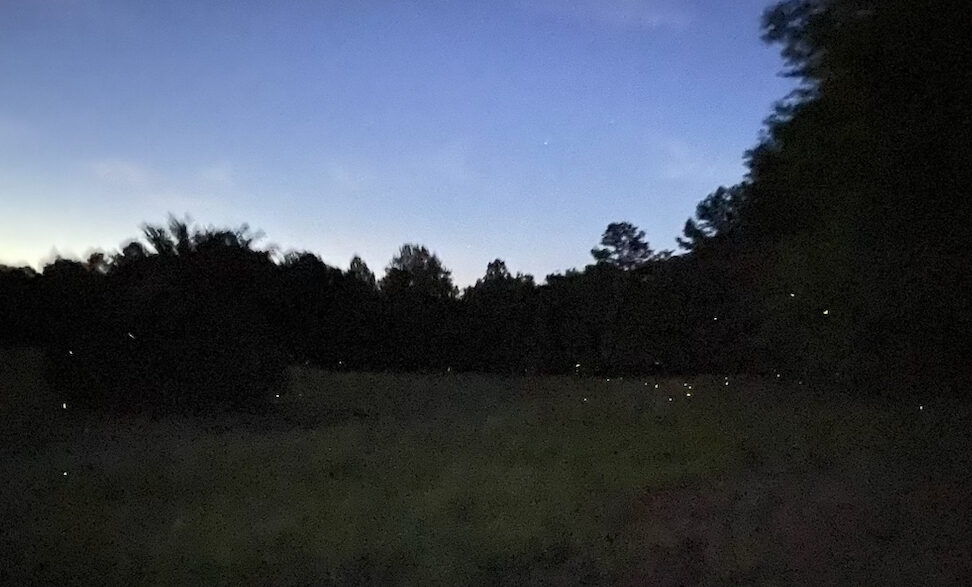My daughter and I stood on the edge of a neighbor’s field, searching the horizon for the northern lights. Although I imagined a little bit of blue flicker here and there above the trees, we were a day late from seeing that spectacular performance. It didn’t matter, however, as the fireflies gave us all the show we needed.
Dozens of fireflies were out, blasting the night with their bioluminescent glow, desperately trying to attract mates. Although my focus was on the night sky, I couldn’t help but be distracted by the pulsating insect beauty around me on such a calm, warm night. It was a perfect evening for all of us.
- RELATED: This is what a meteor sounds like.
Nothing reminds me of my childhood summers more than seeing fireflies, or as we used to call them, lightning bugs. I would chase the insects with an empty jar, tossing them in whenever I managed to catch one, and peering at them for what seemed like minutes but was more likely hours before releasing them unharmed. Even with television, and before video games and the internet, we had the glowing entertainment of insects to occupy our time — and we still do, if we just let them.

It was only much later in life that I realized that they weren’t bugs at all, at least not to science. Fireflies aren’t flies either. They are actually beetles, within the family Lampyridae, which, you guessed it, represents species that shine like a lamp.
There are about 2,000 species of fireflies. They range in size from 2/10 of an inch to full inch long, and not all species can generate light. But most of our eastern species do, and what a show they can put on.
Adults spend most of the single summer of their adult lives searching for a mate, which is the primary reason that they light up. Each flash is a firefly saying, “I’m here!” in an attempt to attract a mate. Both sexes of fireflies flash their lights, but females typically remain in one place, flashing only when they notice a male with an especially impressive display. Each species has its own unique flashing pattern to ensure they are mating with the right insect. Once mated, the females lay their eggs and die shortly thereafter. The next generation emerges the following spring and the cycle begins again.
Fireflies sometimes use their flashes for more than mates. Some species use their light to repel predators or attract prey. Fireflies taste bitter, so predators learn that if it lights up, it tastes bad. Some females will mimic the flashes of females from other species to attract males of these species, which they then attack and consume. Males cannot always assume that females are providing honest signals about mating—they might be waiting to eat them.
Fireflies use bioluminescence, a term that describes how living things create light. Fireflies have light organs that are located beneath their abdomens. These organs contain luciferase, a chemical that when combined with oxygen, calcium, and other common substances creates a reaction that produces light.
Firefly light is perhaps the most efficient light on the planet.
Scientists estimate that almost 100 percent of the energy in this chemical reaction is emitted as light; in comparison, an incandescent light bulb only emits 10 percent of its energy as light, and even the best LED bulbs are not as efficient as lightning bugs, although they come close at 80%. Someday, firefly tech may allow us to improve our own lighting efficiency even further. Other research has discovered new uses for luciferase, including detecting blood clots, evaluating cancer medications, and food safety testing.
Some fireflies, most famously in Southeast Asia, will synchronize their flashes. In the U.S., this phenomenon is commonly seen in Pennsylvania’s Allegheny National Forest and the Great Smoky Mountains. It is unclear exactly why some species synchronize, but it may be a way of males joining forces to attract females or some sort of competition among males to be the first flash.
I’ve observed fewer and fewer fireflies over the years, and others have noticed the same thing. Fireflies are affected by light pollution, which is common in cities, as well as pesticides and habitat loss. Humans use a lot more chemicals on their lawns, gardens, and agricultural lands than they used to. Other studies suggest that fireflies are very site-specific, so when a forest or field is developed into a parking lot, they don’t move to other areas; they just die off.
Personally, I need fireflies to light up my summer nights, reminding me that even as the world changes around us, some things remain the same.
Additionally, fireflies have given us numerous benefits through their bioluminescent chemicals, with more to come. Yet as they flash less and less in our backyards, they are also warning us that our actions have consequences. If we don’t protect the environment, we will continue to lose species, and many species play important roles within the ecosystem that provides the clean air, water, and other things that humans require. If we remove the pieces of the ecological machine, at some point the machine will break. Like other indicator species, firefly flashes are sending us a message that goes far beyond their search for mates or food.
Enjoying the light of the fireflies is one thing that we can all agree on, as they provide a beacon of hope for the future, and perhaps someday the solutions for our energy needs. They also can help us unplug our children and grandchildren, getting them outside and off their screens. Many of us grew up chasing lightning bugs during the summer, but those in recent generation are spending less and less time outdoors. People care for the things they love, but you can’t fall in love with nature if you never experience it. What better pastime to reverse this trend than chasing fireflies? I cannot think of any family activity I’d rather do on a warm evening.
This summer I encourage you and your family to find a dark corner of your yard and enjoy the spectacular, free show. I know that I’ll watch them each and every time I can, freeing that little boy trapped inside me one more time.
This story is republished with permission from the Northern Kentucky Tribune. Read the original.
Dr. Howard Whiteman is a professor in the Department of Biological Sciences at Murray State University and holds the Commonwealth Endowed Chair of Environmental Studies.






